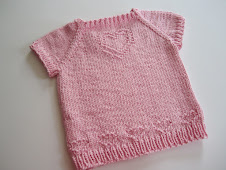I had a marathon knitting session this weekend and I have finally converted the bib patterns into washcloths in response to the many requests I've had. Altogether I knit four washcloths and two bibs! I'll be posting them one by one, but I need to re-check them to make sure I didn't forget any important details! I love this dinosaur in the red! The bib was cute in the green, but don't you think this red just screams "boy"? It gives me an idea for another project altogether. It was pretty hard to get a decent picture for some reason. The design shows up in person really well, but not so much in the picture.

Copyright 2008 by Elaine Fitzpatrick. Permission is granted to reproduce this pattern in any medium, as long as it is distributed for free and this copyright notice remains intact. Permission is also granted to produce items from this pattern for sale.
Pattern has been revised. If you downloaded it before September 8, 2009, you'll need to do it again.
Pattern has been revised. If you downloaded it before September 8, 2009, you'll need to do it again.
Materials: One skein of worsted weight cotton such as Sugar and Cream or Peaches & Crème for a dishcloth, or for a baby’s washcloth, I suggest using something really soft like Bernat© Cottontots.
Needles: Size 6
Gauge: 4.5 sts. per inch, not critical
Abbreviations:
k = knit
p = purl
sts. = stitches
dec. = decrease
B5 = seed stitch border (k1, p1, k1, p1, k1)
Cast on 38 stitches.
Row 1: p1; k1; across row.
Row 2: k1; p1; across row.
Row 3: p1; k1; across row.
Row 4: k1; p1; across row.
Row 5: p1; k1; across row.
(Note: From this point on, keep the first and last five stitches in the established seed stitch for the border. They are referred to as “B5”. You might find it helpful to insert a marker after the first five stitches and before the last five stitches.)
Row 6: B5; p28; B5.
Row 7: B5; k28; B5.
Row 8: B5; p28; B5.
Row 9: B5; k28; B5.
Row 10: B5; p15; k6; p7; B5.
Row 11: B5; k6; p7; k15; B5.
Row 12: B5; p16; k7; p5; B5.
Row 13: B5; k4; p6; k18; B5.
Row 14: B5; p22; k3; p3; B5.
Row 15: B5; k3; p3; k22; B5.
Row 16: B5; p22; k3; p3; B5.
Row 17: B5; k3; p3; k1; p4; k2; p4; k11; B5.
Row 18: B5; p11; k4; p2; k4; p1; k3; p3; B5.
Row 19: B5; k3; p3; k1; p4; k2; p4; k11; B5.
Row 20: B5; p5; k5; p2; k3; p3; k3; p1; k3; p3; B5.
Row 21: B5; k3; p3; k1; p3; k3; p3; k2; p5; k5; B5.
Row 22: B5; p5; k5; p2; k3; p3; k7; p3; B5.
Row 23: B5; k3; p8; k2; p3; k1; p4; k7; B5.
Row 24: B5; p8; k3; p1; k13; p3; B5.
Row 25: B5; k3; p17; k8; B5.
Row 26: B5; p9; k16; p3; B5.
Row 27: B5; k4; p15; k9; B5.
Row 28: B5; p10; k14; p4; B5.
Row 29: B5; k5; p13; k10; B5.
Row 30: B5; p10; k13; p5; B5.
Row 31: B5; k6; p12; k10; B5.
Row 32: B5; p10; k11; p7; B5.
Row 33: B5; k7; p11; k10; B5.
Row 34: B5; p10; k10; p8; B5.
Row 35: B5; k9; p9; k10; B5.
Row 36: B5; p10; k8; p10; B5.
Row 37: B5; k11; p7; k10; B5.
Row 38: B5; p10; k6; p12; B5.
Row 39: B5; k12; p6; k3; p3; k4; B5.
Row 40: B5; p3; k5; p2; k5; p13; B5.
Row 41: B5; k13; p12; k3; B5.
Row 42: B5; p3; k12; p13; B5.
Row 43: B5; k14; p11; k3; B5.
Row 44: B5; p4, k3, p1; k6; p14; B5.
Row 45: B5; k15; p8, k5; B5.
Row 46: B5; p6; k6; p16; B5.
Row 47: B5; k17; p3; k8; B5.
Row 48: B5; p28; B5.
Row 49: B5; k28; B5.
Row 50: B5; p28; B5.
Row 51: B5; k28; B5.
Row 52: k1, p1 across row.
Row 53: p1, k1 across row
Row 54: k1, p1 across row.
Row 55: p1, k1 across row.
Row 56: k1, p1 across row.Bind off.

